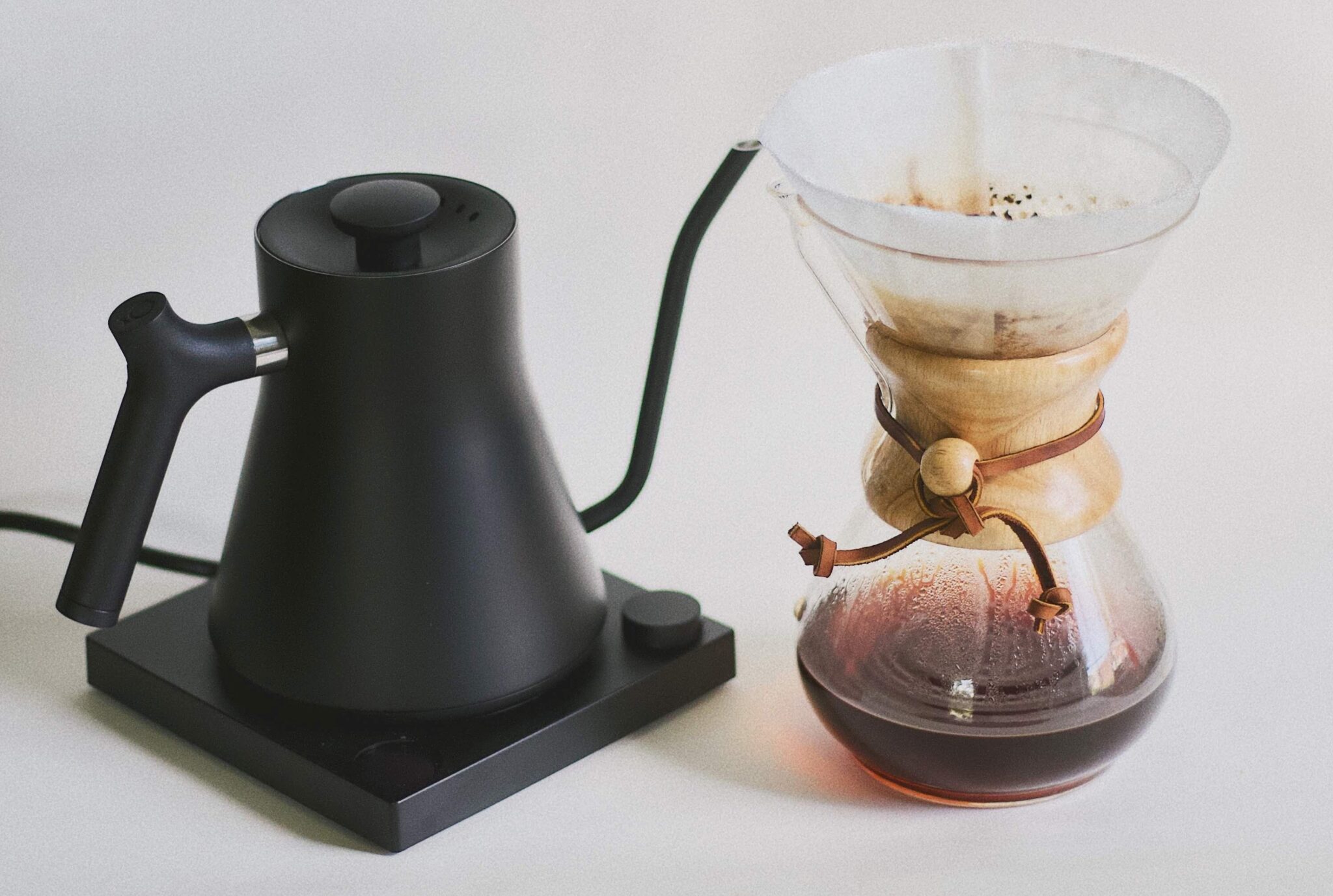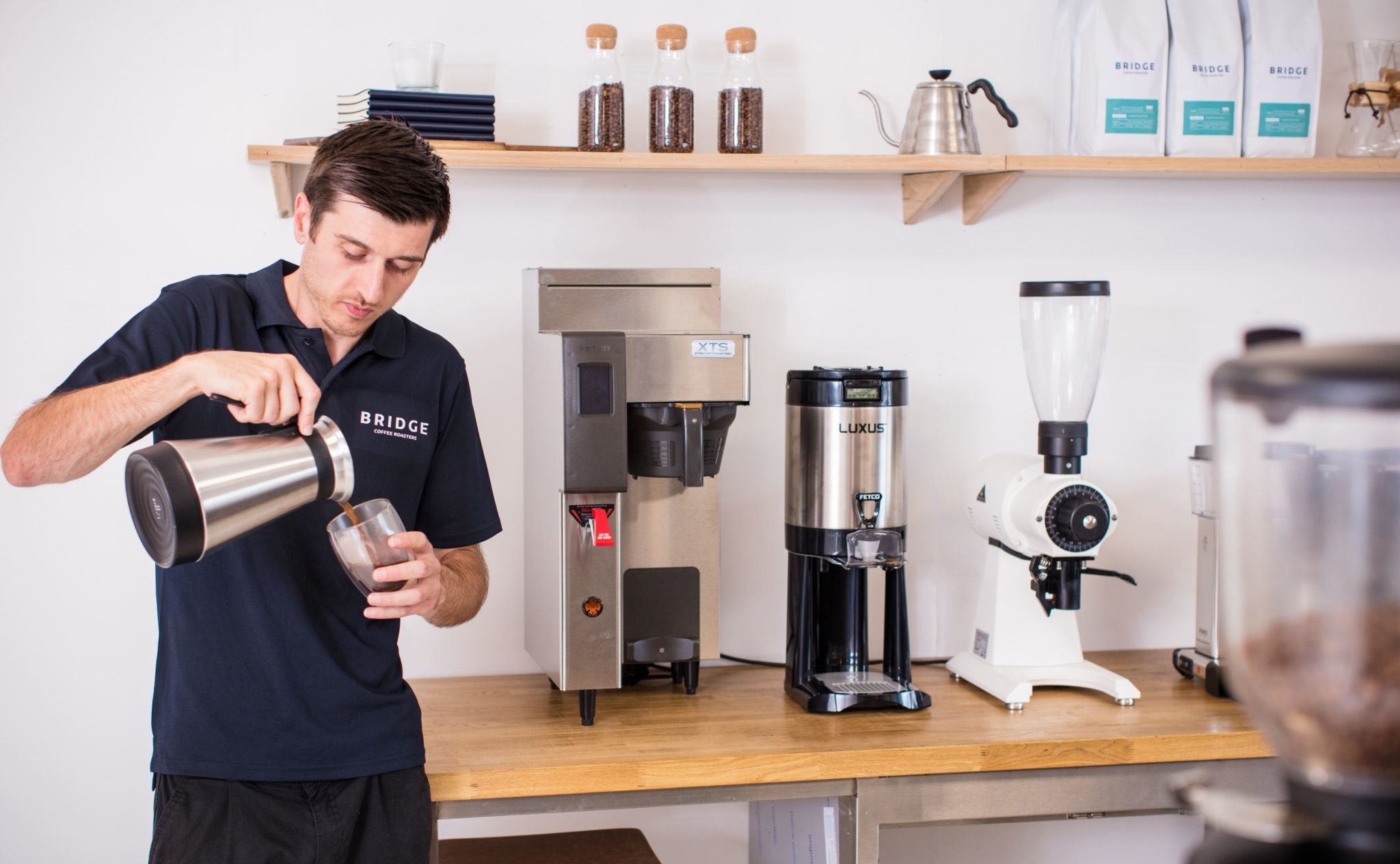The word on the coffee street at the moment is that filter coffee has become the newest big thing.
Of course, we have all been riding the espresso wave for the last few years and filter coffee had been left back on the beach, so maybe a little reminder of what the difference is between filter coffee and espresso is in order. The basic principle is the same with both methods of extraction. The green coffee bean is roasted and then ground, and hot water (in the vast majority of cases) is passed through the grinds to extract the flavour. The key difference between espresso and filter coffee though, is that with espresso, extremely hot water is forced under high pressure through the coffee grounds whereas filter coffee, with a couple of important exceptions, simply allows the water to flow naturally through the grounds at its own speed. The impact on the final drink can be like the difference between flying from one city to another and taking the train.
One is much faster, and you are shown a vast canvas of land and sky. It is easy to be blown away by the glorious beauty and wonder of it all. On the train, even though you are moving between the same two cities, you have a better chance of taking in individual copses of trees, fields of waving corn and even a lone fox leaping up an embankment. The flavour of an espresso is generally seen as more intense, possibly more bitter, or with more acidity, and as having a longer lasting after-taste. Filter coffees, on the other hand, are often regarded as a better vehicle for a milder experience which can showcase the coffee’s individual taste-notes with greater clarity.
Types of Filter Coffee
As filter coffee is mainly intended to be drunk without milk, its main variations are in the filter process rather than in ratios of milk to coffee or importance of microbubbles to be found in differentiations between flat whites, lattes and cappuccinos which are made with espresso shots. The two most common processes in making filter coffee are the pour over and the batch brew.
Pour Over
For a pour over, coffee grounds are measured into a filter paper which is held in a funnel over a jug or flask that collects the extracted coffee. Initially the coffee is allowed to “bloom” by pouring a little of the hot water onto the grounds and leaving them briefly, and then pouring the rest of the water carefully onto the grounds. As the water ‘filters’ through the grounds it extracts the flavours and gradually the coffee drips into the jug, which is why pour-over is sometimes called a drip filter.
The V60 is a classic and extremely popular version of this brewing method. Its iconic handle and gently ribbed v-shaped funnel with a disc to rest on the mouth of your cup has been at the forefront of the rebirth of the filter coffee and has spawned a multitude of imitators and many more converts to the coffee it produces. Similarly, the Nordic simplicity of the Chemex with its flask and funnel joined by a sinuous, tactile, wooden ring has become a design classic, firmly displayed in the kitchens of the urban cool across the world. The Chemex was actually invented in America and is now a part of the permanent collection of the New York Museum of Modern Art.

Batch Brew
Here, the clue is in the name. Batch brew is a filter method which is intend for making larger quantities of filter coffee. The filter process is markedly slower than that of making an espresso and, as a consequence, making larger quantities of filter coffee takes even longer. Batch brewing is an automated process which makes it possible for a barista or coffee shop to make good quality filter coffee in larger quantities.
It used to be that the thought of automated filter coffee machines conjured images of old American cop shows with a gnarled, exhausted policeman pouring a cup of coffee from a dirty filter machine, spitting it back into the cup and putting a cigarette out in the rejected drink. For many years, this image haunted the perception of the batch brew and kept it very much the poor cousin of pour overs and espresso.
With the birth of third wave coffee and the wider availability of speciality coffee alongside a more educated body of coffee lovers this perception started to change. What batch brew now does, is provide a cost effective, efficient, and simple method of producing high quality filter coffee in quantities which allow it to be offered at a favourable price.

Why is Filter Coffee so Popular Now?
The world of speciality coffee is one with a great sense of theatre and an appreciation of artistry and knowledge. Espresso coffee held centre-stage with glamorous coffee producing nations, flashy machines, heat, steam, powerful flavours, latte art and the subtle and complicated science which lay behind the best coffee.
As filter coffee has come of age, it has stepped onto the stage to steal the limelight. The performance is longer and more refined: in a process which conjures to mind the stereotype of the Japanese tea ceremony, the barista reverently spreads the grounds into the filter rather than crushing them cruelly into a tiny portafilter. With an exotic swan necked kettle, just the right amount of water is carefully poured onto the grounds. Then there comes an almost meditative pause lasting tens of seconds as nothing happens but the gradual absorption of water. Then the barista returns to the task pouring the remaining water in gentle circular motions: there is no haste or noise, just a calm motion which reflects the style and method of the individual barista. After that, only gravity is allowed to intervene in the process as the water gradually seeps through the grounds and slowly and enticingly drips.
Even more importantly, the coffee fan who has been promised notes of plum, toffee and citrus so many times is now presented with a drink which is gentle and subtle enough that without the interference of milk it can be enjoyed, savoured and investigated with a much more accessible clarity.
Although this is not true of the batch brew, what the batch brew does is fulfil a purpose for both the experienced, and the inexperienced filter drinker. For the experienced filter fan, it is a quicker and often slightly cheaper way of enjoying their coffee. For the inexperienced filter drinker, a canny barista can use it to entice the customer as it provides an ideal opportunity to offer a ready sample to introduce them to the wonders of filter coffee.
What has also driven this rise in popularity is the simplicity and beauty of the pour-over equipment for the home user. For a speciality coffee aficionado who doesn’t have the space for an espresso machine or who doesn’t want to invest in one, the pour-over provides an opportunity to enjoy and experiment with world class coffee in their own home.
Bulk Brew and Filter Coffee
Discover our range of Bulk Brew and Filter Coffee options and get in touch with the team if you want to discuss a solution for your business.
Discover
